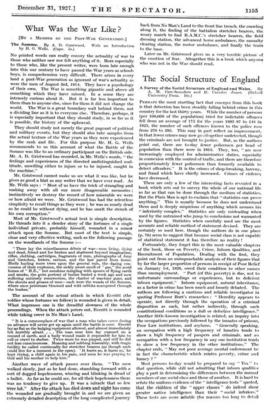The Social Structure of England A Survey of the Social
Structure of England and Wales. By A. M. Carr-Saunders and D. Caradoc Jones. (Oxford
University Press. 10s.)
PERHAPS the most startling fact that emerges from this book is that detection has been steadily falling behind crime in this country for the last thirty years. While the number of persons (per 100,000 of the population) tried for indictable offences fell from an average of 175 for the years 1893-97 to 148 in 1925, the number of such offences known to the police rose from 270 to 293. This may in part reflect an improvement, in that fewer crimes may now go altogether undetected, though the criminals are not brought to justice. But, as the authors point out, there are to-day fewer policemen per head of population than there were in 1913. They, too, "are now increasingly employed for administrative duties, especially in connexion with the control of traffic, and there are therefore proportionately fewer policemen than formerly available to detect offenders." It is the crimes of shop-breaking, larceny, and fraud which have chiefly increased. Crimes of violence have decreased.
These are only a few of the interesting facts revealed in a book which sets out to survey the whole of our national life as far as that can be done through the medium of statistics. But the Plain Man is apt to exclaim that "statistics can prove anything." This is usually because he does not understand them and is deeply stApicious of anything which arouses his "inferiority complex." Statistics are only misleading when used by the untrained who jump to conclusions not warranted by the figures. Statistics when carefully used are the most accurate and reliable method of statement devised. They arc certainly so used here, though the authors do in one place (p. 70) seem to suggest that because social class is not capable of statistical statement it has therefore no reality !
Fortunately, they forget this in the most valuable chapters of the book, those on Poverty, Crime, Inborn Qualities, and Recruitment of Population. Dealing with the first, they point out from an unimpeachable analysis of their figures that by far the larger proportion of persons in receipt of Poor Relief on January 1st, 1926, owed their condition to other causes than unemployment. "Part (of this poverty) is due, not to unfortunate surroundings or experiences, but to deficient inborn equipment." Inborn equipment, natural inheritance, as a factor in crime has been much and loosely debated. The authors are following a cautious and reliable investigator in quoting Professor Burt's researches : "Heredity appears to operate, not directly through the operation of a criminal disposition as such, but rather indirectly, through such constitutional conditions as a dull or defective intelligence."
Another little-known investigation is related, an inquiry into the occupations previously followed by the inmates of prisons, Poor Law institutions, and asylums. "Generally speaking, an occupation with a high frequency of lunatics tends to show a high frequency of paupers and criminals, and an occupation with a low frequency in any one institution tends to show a low frequency in the other institutions." The chapter ends, "May not poor average mental endowment be in fact the characteristic which relates poverty, crime and lunacy?"
Most persons to-day would be prepared to say " Yes " to that question, while still not admitting that inborn qualities play a part in determining the differences between the normal members of one social class and those of another. It is hard to refute the uniform evidence of the" intelligence tests " quoted,
that the children of the "upper classes" do indeed show greater native intelligence than their "social inferiors." These tests arc more reliable (for reasons too long to detail -
here) than at first appears. But, even granting with the authors that superior environment is in part responsible for the better performances of the upper-class children, it cannot be wholly responsible. The differences revealed by the tests are largely differences of innate ability. Moreover, we have yet no measuring rod for temperament, which probably more than any other quality marks off one man or type from another. Character, rather than brains, is responsible for success or failure in life.
Assuming that there is any difference, however small, between the innate qualities of the classes, the last chapter on "Recruitment of Population shows a serious state of affairs. As long ago as 1911 the effective fertility of the upper and middle classes was only 168 children per 100 families (still fewer among the true professional class) against 268 children among unskilled labourers. There are no .exactly comparable figures from the Census of 1921, but it is clear that the gulf is just as large, a fall in the birth-rate of the labourers being compensated for by a fall in their death-rate—which is also, of course, by so much the less selective. The character of the population, as far as innate qualities are concerned, is rapidly changing, the proportion of those classes upon which we chiefly depend for leadership and intellectual eminence steadily diminishing. All such changes are cumulative. The present reviewer cannot even agree with the authors that the effective fertility of degenerate stocks, at least, is happily lower than the normal. There is reliable evidence (apparently not known to the authors and too long to be given here) that these stocks are increasing more rapidly than the rest of the population, of which they already form at least 1 per cent.—probably much more, since the Poor Law relieves nearly 4 per cent.
This highly readable work only lacks an • index to make it an invaluable reference book.



























 Previous page
Previous page